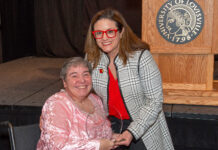The law opened access for African Americans to eat in public restaurants, shop in stores and attend theaters that before had been segregated.
Some people at the ceremony to unveil a new historical marker had participated in the sit-ins, marches and voter registration effort that took place between 1961 and 1963 and which led to a change in the makeup of local government and the law’s passage.
The sit-ins and demonstrations in Louisville were peaceful at a time when violence marked demonstrations in other cities, said John Ferré, interim dean of the College of Arts and Sciences.
“This marker represents a hard-fought piece of our history, and I want to thank people here today who are part of that history,” Louisville Mayor Greg Fischer said at the event.
The College of Arts and Sciences, under the leadership of the late Blaine Hudson, was a catalyst for the marker project. Ultimately there will be 12 markers at locations along South Fourth Street and West Broadway which figure into the movement’s history.
“These markers are a way to bring history to life,” said Provost Shirley Willihnganz, adding that markers in UofL’s Freedom Park also serve to educate. “We’re proud of these markers that will celebrate and educate about what needs to be told.”
Artist Ed Hamilton designed the artwork for the markers. Tracy K’Meyer, UofL history department chair, wrote the text for the initial marker, which provides an overview of the movement.


























